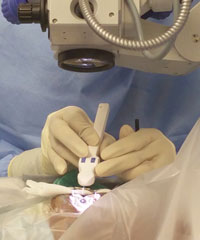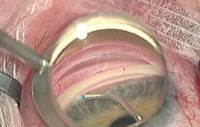 |
 |
One of the newest options for minimally-invasive glaucoma surgery (MIGS) is Visco360 (Sight Science), which was released this year and provides a new approach to viscocanaloplasty. While research from the last 10 years shows that ab externo canaloplasty can effectively lower intraocular pressure (IOP) in open-angle glaucoma patients, the procedure can be technically challenging.1 This new surgical option allows clinicians to perform viscocanaloplasty with an internal approach through the same small corneal incision used in cataract surgery, making it a much faster, less intrusive procedure that spares the conjunctiva and can lower IOP. It facilitates the delivery of small, controlled volumes of viscoelastic fluid in the space of Schlemm’s canal behind the trabecular meshwork (TM) to improve outflow. This can separate compressed tissue planes where there could be adhesions, which dilates the canal and the more distal collector channels, improving aqueous outflow.
 | |
| Dr. Okeke using the Visco360 device. | |
 | |
| The advancement of a flexible injection tube past the TM into Schlemm’s canal. |
Surgical Technique
If combined with cataract surgery, Visco360 is performed first. The device is primed by instilling viscoelastic prior to the start of the procedure. A corneal incision with a blade is made temporally, and the anterior chamber (AC) is filled with viscoelastic. The device is advanced across the AC and, with the help of a gonioprism, the tip of the device makes an initial incision through the TM to provide a track for entry into Schlemm’s canal. Rotating a control wheel allows advancement of a flexible injection tube into Schlemm’s canal for up to 180 degrees. The injection tube is then retracted and an infusion pump slowly releases the viscoelastic. After this is completed in one direction, the device is turned to repeat the process in the other direction for up to another 180 degrees. There may be a small egress of heme from Schlemm’s canal with the initial incision though the TM, but it is minimal. Once completed, if a stand-alone procedure, the remaining viscoelastic is removed from the AC, and the corneal wound is hydrated with a watertight seal, typically without the need of any sutures. If combined, the surgeon proceeds with the cataract surgery.
Advantages and Disadvantages
Unlike other MIGS procedures, Visco360 tissue, does not require permanent placement of an implant and treats up to 360 degrees of the outflow system. It is indicated as a stand-alone procedure in phakic or pseudophakic patients and can be easily combined with cataract surgery. It has a disposable, single-use instrument and typically takes less than 10 minutes. There is minimal hyphema, and there is an already established procedure code, which improves its insurance coverage.
One major disadvantage is that it is an extremely new device, and the clinical trial results are sparse so far. Time will tell if this device will remain a viable MIGS option.
Dr. Okeke is an assistant professor of ophthalmology at Eastern Virginia Medical School and a glaucoma specialist and cataract surgeon at Virginia Eye Consultants in Norfolk, Va.
1. Lewis RA, von Wolff K, Tetz M, et al. Canaloplasty: three-year results of circumferential viscodilation and tensioning of Schlemm’s canal using a microcatheter to treat open-angle glaucoma. J Cataract Refract Surg. 2009 May;35(5):814-24.
